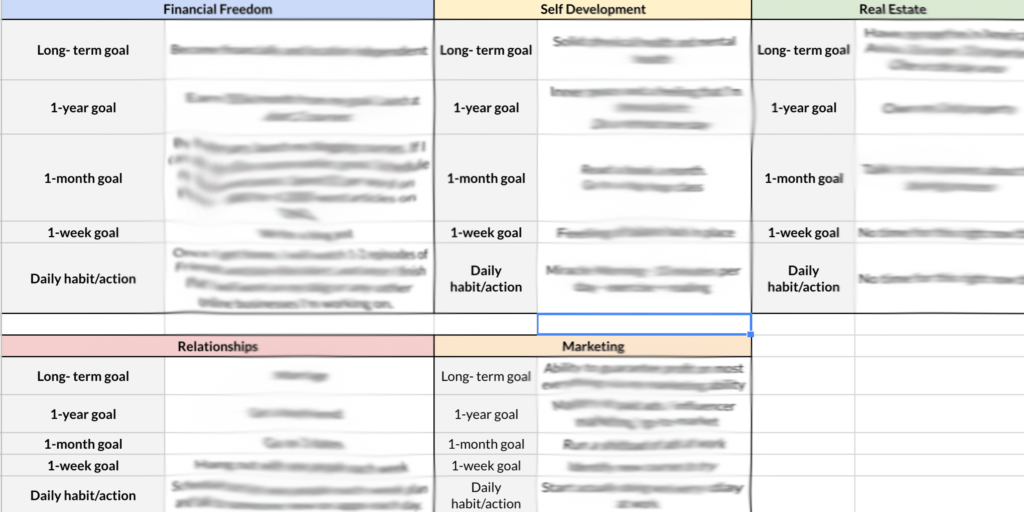This is going to be a lofty post because I find it vital to learn how to set goals and achieve them. I’ve wanted to make this post for a while now, but I’m only getting to it now as I have a more comprehensive view on building out life plans. I’ve completed a few goal-planning exercises circulating around the internet that I’ve integrated into my existing action plans. It is extremely necessary to do some smart goal setting especially when trying to design your life, build passive income, and pursue financial freedom. If you’re not aware of where you are currently and what your purpose is, it’s hard to make the deliberate actions needed to live your best life and achieve your goals.

Before I started traveling, I took 2 remote freelancing positions on top of my full-time work, while working on music and passive income. It was pretty insane. I was gearing up for my travels and wanted to build up my income channels as well as save up as much capital as I could in preparation for my trip. And while I was nomading, living month-to-month in different locations, I was able to build my passive income channels up to $4k/month, all while traveling and living life. Everything required balance, goal setting, and planning.
Though I always think I can do better, people seem to think of me as productive with a knack for balancing many different projects at once and completing them from start to finish. Because of this, people tend to ask me for advice on how to get shit done. I’d like to share my guide on how to set goals and achieve them, and I hope this post will be beneficial for you!
How to Set Goals and Achieve Them
In these last few weeks, I actually found myself slightly falling behind on life. The struggle began after I recently moved and began working on a course with my friend. Many of my daily habits and schedules were put on hold as I focused solely on the course. I didn’t even hang out with anyone else except my friend for 3 weeks. And health-wise, I barely moved. A lot of my time was spent sitting in front of a computer, either at the office or on the couch working on the course. I was a mess!

Now that my friend has left, I’m getting back to my personal goals and figuring out my balance again. I completed the exercises from Build a Better Life course and Tyler Pearson’s How to Create a Personal Vision Statement. Then I integrated these with my personal monthly tracker that I use to get my shit together. It seems excessive, but I realized more and more that self awareness, tracking of your current activities, and understanding of your bigger picture goals are key to living your best life.
A part of me was wondering if I needed to be more present rather than look so outwardly towards the future. However, after doing these exercises, I realize it’s more about making sure you’re taking the right actions towards your best life rather than constantly thinking about the future. It’s about making sure you’re in line with your purpose and that you’re in tune with your true self. For example, if you hate your job, you may want to do some self evaluation about where you see yourself in the future and if your job is actually pushing you towards your true goals. Then you can figure out if you want to pivot and do what you love. Or, if you find your social life is lacking, you can make quantifiable goals to visit meetups to meet new people. And even if you don’t make new friends, you’re giving yourself more opportunity to do so by actively increasing the pool of people you meet on a day-to-day basis.
The Organization of My Goals, Schedules, etc.
I currently have a Drive folder in which I have all the documents from completing the exercises in Mark Manson’s Build a Better Life course and Tyler Pearson’s How to Create a Personal Vision Statement. I like to use Google Docs for reading my bigger picture visions, and Google Sheets as more of a tracker and scheduler.

I incorporated my own tracker with takeaways from Mark Manson’s and Tyler Pearson’s exercises.
The Mark Manson Way
I purchased a subscription to Mark Manson‘s website a few weeks ago and took his courses. His first course, “Build a Better Life”, already prompted a lot of action on my end.
Something I really liked about “Build a Better Life” was that he mentioned a fulfilling, balanced life includes 3 pillars: freedom, health, and relationships. Usually people would replace “freedom” with something like “money” or “passion”. I liked how his was a bit different, and it really makes sense when you apply it to the masses. For example, I have met many people who have yet to find their passions, and others who don’t value money at all. I personally don’t need a substantial net worth to be happy either as I’m not much of a spender – I just want that cashflow to have that freedom to live the life I want. So I really like how “freedom” was in place of those other values, and I like that idea that it’s a triangle in which you can’t just focus on one or the other at the expense of 2 of the 3 pillars.
You can either take the course, or you can view my little summary of the exercises below. However, I found value in reading what Mark Manson had to say on building a better life so his course will have much more information than this little summary below.
- Write down your bucket list or everything you want to do in your life before you die
- Describe your ideal life five years from now
- Describe your ideal life one year from now
- Write down your daily activities, time spent, and fulfillment rating per activity
- Each of these activities should include hours per week and fulfillment ratings from 1-10. Even a certain activity like “playing board games” could be fulfilling for you and not another, so by quantifying how much value you get from each activity you will understand if you need to adjust your current situation or keep it as is. If you get a lot of value from playing board games then maybe you can keep it within your list of daily activities.
- Write down the habits you want to create
- Each of these habits should include a cue -> behavior -> reward, unless the reward is in the behavior itself.
- An example of this would be: “Each morning after brushing your teeth, do a minimum of 10 minutes of meditation with Calm or Headspace.”
- Create the Action Plan
- This plan basically incorporates all of your learnings and brainstorming from the previous questions. You would create charts including your long term goal, 1-year goal, 1-month goal, 1-week goal, and daily habit/action
I filled out his exercises and wrote them in my Google Doc titled “Mark Manson Goals”. There, I extracted my action plan and 5 year + 1 year goal answers and dropped them into my spreadsheet. I made separate sheets under the Google Spreadsheet titled “Monthly Tracker”:

Here’s what it looks like (JFYI I’ve blurred/smudged out my answers. I apologize for the squiggliness.):


I found the Mark Manson exercise useful for understanding my bigger picture goals and tying them together with my milestones and daily/monthly schedule. I also found it interesting gauging how I’m currently spending my time and how I could improve my time allocation.
The 25-Year Vision
I also completed the 25-year vision exercise I found on Tyler Pearson’s How to Create a Personal Vision Statement. My friend Mike sent me the article (and I’m super glad he did). Since you can view this article publicly, I would advise going into it and actually completing the exercises. They even have a link to the Google Doc template of the exercises where you can make a copy and fill it out yourself.
Below is a summary of the questions to complete for your 25-year vision:
- If you were reading this twenty five years from today, and reflecting on the events of those twenty five years, what has to have happened in your professional life for you to feel successful?
- Write everything and make sure it is terrifying and almost embarrassing to read! Your goals must scare you.
- What challenges need to be overcome?
- For each goal, write the challenges, and 5 reasons (if you can) of why you haven’t overcome the challenges.
- What opportunities need to be captured?
- Different events you need to happen in order to achieve your goal.
- What strengths need to be leveraged?
- The different strengths you have that can help pave the way to success.
After you’ve brainstormed, you’ll also create your 25-year vision which is based on everything you’ve gathered.
- Role: What someone living your dream life would be called.
- In his example he wrote: “Democratizer of the Entrepreneurial Economy”. I believe he wanted to do this to create more of a visual attached to your 25-year old self that you can think of.
- Why You Want It
- What You Want
- What that looks like on a day-to-day basis
I put all of my answers on my Google Doc titled “25 Year Vision” and I took some of my favorite parts and dropped them in the “Monthly Tracker” spreadsheet. This is what the part outlining my 25 year vision looks like:

This 25 year vision makes it so that you have that bigger picture idea of your life. The author of that article mentions that the flaw with 5 and 1 year plans is you get discouraged when time is running out and you haven’t completed your goals. I still find it really helpful to have the 1 year and 5 year plans in place, but I also really liked making the 25 year vision. It is a constant reminder of what my best life looks like, and it gives me the “why” and the “what” of my endeavors rather than merely the “how”.
When I started writing out my 25 year vision, I realized that in 25 years I’m going to be in my 50’s. It’s almost like planning out my 2nd life, and it forced me to quantify what I ULTIMATELY wanted, not just in 5 years time. It made me think deeply about my life purpose and vision, and tested whether it all even made sense. For example, my friend told me her friend has a goal of a $5 million net worth. I laughed and thought a bit excessive. I thought maybe a $2 million net worth (based on the Bay Area) would be fine to retire off of. But then I realized my cashflow goals of $50-100k/month would definitely exceed that net worth goal. So it made me wonder if it was all that necessary. The 25 year vision just gave me more questions to think about.
My Personal Monthly Tracker
Now that I had all of these exercises figured out and placed in the correct sheets and docs, I focused on my monthly tracker that I created for myself. It has personally helped me a lot.
My monthly tracker includes the following:
- Month
- My One Thing
- This was based off of Gary Keller’s book “The ONE Thing” which talks about achieving more efficiency by only focusing on one item at a time. Though I technically have a bunch of tasks on my monthly schedule, I still maintain that “one thing” focus by putting this in a column on the tracker.
- Tasks
- This includes other necessary tasks that still help with my overarching goals.
- Finished
- In Progress
- I like to have this column because it helps motivate me on tasks that have multiple components. For example, I might say I want to complete 4 blog posts this month. I would move this into the progress column when I’ve written one, and write (1/4) next to the task. And when it’s fully finished I put it in the “finished” category.
- New Ideas
- I have a column for new ideas because I tend to have a ton of newly sparked ideas along the way as I’m doing these tasks. These help for future goal setting, in case I think of really good ideas that may change my milestones/goals.

The exercises I did with Mark Manson and Tyler Pearson really made sure my monthly tracker aligned with my true self. In the past I would occasionally spend too much time on the wrong tasks. Having the bigger picture vision and action plans allow me to make sure that even my One Thing connects with my best life.
I recap on my monthly tracker constantly, and I plan to recap and revise my 1, 5, and 25 year visions every few months.
Summary
I think different action plans work well with different people, so my monthly tracker may not be good for others. Feel free to change and use different forms of the methods I have mentioned. Based on everything I’ve learned, I’ve come up with a few different components that are generally positive/necessary for a good action plan.
Planning
1. Create a bigger vision
What do you want in your life? How do you imagine your life in the future? And keep in mind the 3 pillars that Mark Manson mentioned for a fulfilling, balanced life: freedom, relationships, and health. It’s important to have a bigger picture vision so that you understand why you’re doing the things you do. It will keep you motivated and on track by writing down your thoughts on this.
2. Figure out your current situation
By writing down your current activities and how you allot your time, you will get a better sense of what can be adjusted to help you to achieve your goals. Comparing your current time allotment with your plan will also make sure you shift each action of your daily life to be more deliberate and less time-wasting.
Financially, one of the best ways to start evaluating your current situation is by tracking your net worth. Personal Capital is a site that allows you to track your net worth and debt online. Best of all it is free! The great thing about checking your net worth is you can track how far you are from your financial goals and adjust your strategy accordingly. Sign up for Personal Capital here.
3. Create your SMART goals based on your bigger vision
You’ve probably heard of SMART goals. Using the SMART method is a solid way to make sure you’re making GOOD goals. It represents the following:
- Specific
- I would say “specific” and “measurable” go hand in hand. You want to make sure you know exactly when you’ve accomplished your goals. For example, vague objectives like “I want to be happy” or “I want to become healthier” can mean so many things.
- Measurable
- Solid goals are quantifiable. Rather than jotting down some general wishes like “I want to read more”, I would say something like “I am going to read 10 books by end of year.” That way I know how far I am with my progress and can easily say whether or not I have accomplished the goal.
- Attainable
- You want to make sure your goals are attainable. It’s okay if your 25 year vision is a bit out of reach for now. But if your 1-year is totally unattainable, it may discourage you from working as hard as you could.
- Relevant
- This ties back to the ultimate vision. You want to make sure that the milestones and goals you jot down are relevant to your bigger vision.
- Time-based
- By setting time oriented goals like 1-month and 1-year, you’re creating deadlines for what you want to achieve to keep you on track.
4. Create an Action Plan
Your action plan should include smaller scale milestones that will help you reach your goals. You’re basically breaking down your goals into smaller units to make them more achievable.
5. Hold Yourself Accountable
Take responsibility for your goals. Accountability may come from the awareness you get through all of these exercises. For me, what keeps me accountable is understanding that my life is my responsibility. I want to make sure that when I die, I can reflect on my journey with happiness.
If that doesn’t drive you enough, having accountability partners and systems in place can help as well. I have one friend who places bets with his friend, and when they fail to keep up with a habit they have to pay the other person. I have another friend who joined a group that pools their money, and whenever they don’t achieve their goals they forfeit their contribution. But even having a general accountability partner can keep you on top of things, just because you want to avoid that guilt if you fail to achieve whatever you need to achieve.
6. Recap and Revise
Your goals tend to change overtime. Make sure to keep recapping and revising to keep the goals in line with your vision.

I hope this article helped. If you haven’t done any goal setting or planning, try implementing the exercises I linked to above as well as my personal monthly tracker.
How do you create your goals and achieve them? Let me know in the comments below!

